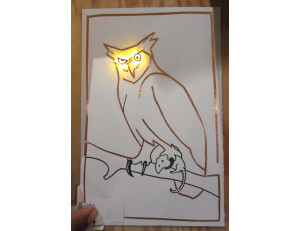
I am delighted to share with you an activity I just did in one of my classes. This is a basics activity. That means that I use this activity to teach basic principle and skills. We will later use these principles later to do a bigger project.
For this project, you need paper, scotch (clear) tape, binder clips, copper foil tape, 3volt button cell batteries and LEDs. I found adafruit.com a great place to get the Copper Foil Tape and 3V Button Cell CR2032 batteries. Makershed had a great collection of 100 LEDs for about $10. I did find it interesting that adafruit also had a rechargeable button cell battery. Of course, you also need the charger. If anyone has used the rechargeable battery and charger, I would love to hear how they work.

A couple things that you want to cover right away is that electricity is unpredictable. We can guess what it will do and where it will go, but we can’t always be sure. Just try to predict a lightning strike. So, talk about safety and talk about polarity. Talk about Positive and Negative or Anode and Cathode. This becomes very important when working with direct current. The battery will only work when connected correctly and the LED will only light when connected correctly. Batteries are clearly marked + or – but LEDs, not so much. So, how do you tell? Sparkfun does a great job of explaining polarity.
 It is always good to have everything put together in packs for the kids to make things go smoother. Another thing that made things go smoother was I had the circuits already printed on the paper for them. First, we started with a simple circuit. Then, we did a second circuit that includes a switch. You can print the pages I used by clicking on the image and downloading the pdf. These are simple drawings that I just had the kids tape the copper foil over the black lines. While I drew these up myself, I can’t take credit as there were basically of mashup of a couple sites. I’ll list some of my favorites at the end of the post.
It is always good to have everything put together in packs for the kids to make things go smoother. Another thing that made things go smoother was I had the circuits already printed on the paper for them. First, we started with a simple circuit. Then, we did a second circuit that includes a switch. You can print the pages I used by clicking on the image and downloading the pdf. These are simple drawings that I just had the kids tape the copper foil over the black lines. While I drew these up myself, I can’t take credit as there were basically of mashup of a couple sites. I’ll list some of my favorites at the end of the post.
To make things a little more fun, have them sketch a fun drawing with a component that will light up. We used a Christmas tree for our simple circuit and a light house for the circuit with a switch.
hackademia – I love the way they integrated the circuitry into a pop up card.
exploratorium – had two links Paper Circuits and Tinkering with Paper Circuits.
High-Low Tech – a research group at the MIT Media Lab had some very useful information including diagrams and an informational handout. Just check out the owl at the top of the post. This led me to…
The Fine Art of Electronics – there are some awesome Tutorials and an amazing gallery, here are some of my favorites, and links to circuit notebooking.